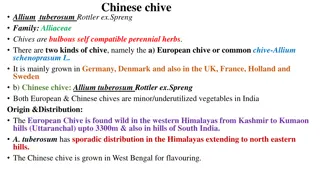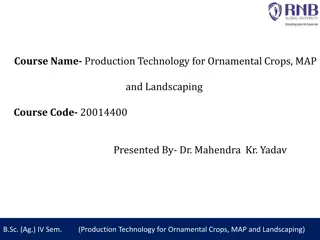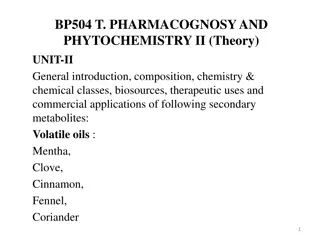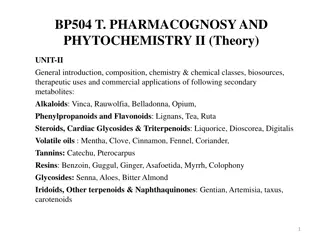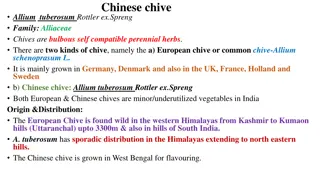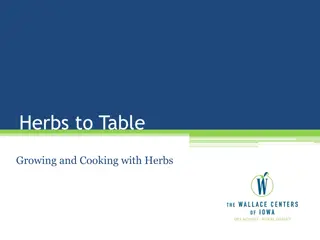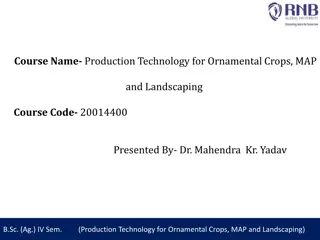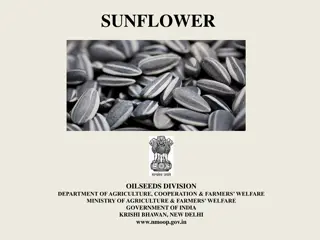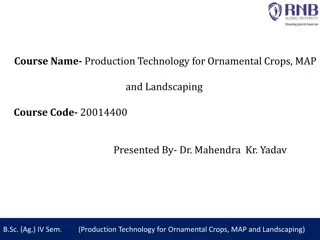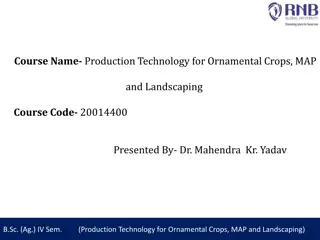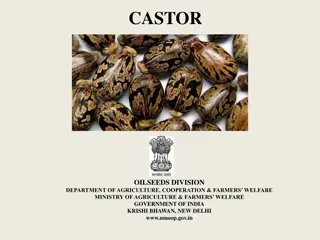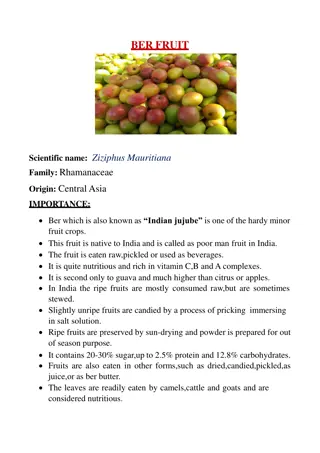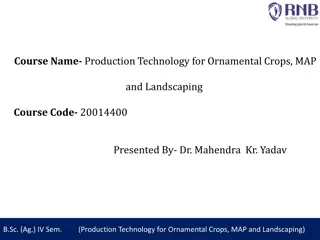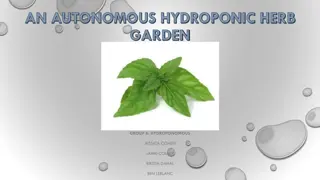Production Technology of Costus: Medicinal Herb Cultivation and Uses
Explore the production technology of Saussurea costus, a medicinal herb valued for its tonic, stimulant, and antiseptic properties in Ayurvedic medicine. Discover its uses in traditional Chinese medicine, aphrodisiac qualities, and benefits for various health conditions. Learn about cultivating Costus in sandy textured loam soil for optimal growth.
Download Presentation

Please find below an Image/Link to download the presentation.
The content on the website is provided AS IS for your information and personal use only. It may not be sold, licensed, or shared on other websites without obtaining consent from the author. Download presentation by click this link. If you encounter any issues during the download, it is possible that the publisher has removed the file from their server.
E N D
Presentation Transcript
Course Name- Production Technology for Ornamental Crops, MAP and Landscaping Course Code- 20014400 Presented By- Dr. Mahendra Kr. Yadav B.Sc. (Ag.) IV Sem. (Production Technology for Ornamental Crops, MAP and Landscaping)
Course Objectives Identify different types of ornamental and medicinal crops. Examine various principles of landscaping, uses of landscape trees, shrubs and climbers, production technology of important ornamental crops, etc. Determine about Demonstrate various Package of practices for loose flowers and their transportation, storage house and required condition for cut and loose flower. Construct about the various problems with the production technology of medicinal and aromatic plants. Importance of Processing and value addition in ornamental crops and MAPs produce. B.Sc. (Ag.) IV Sem. (Production Technology for Ornamental Crops, MAP and Landscaping)
Production technology of costus B.Sc. (Ag.) IV Sem. (Production Technology for Ornamental Crops, MAP and Landscaping)
Production technology of costus Botanical Name : Saussurea costus Family : Compositae Plant Part use -Roots contain Diosgenin and steroidal sapogenins Medicinal use of Costus: Costus is a commonly used medicinal herb in China and is considered to be one of their 50 fundamental herbs. It is also used in Ayurvedic medicine where it is valued mainly for its tonic, stimulant and antiseptic properties. B.Sc. (Ag.) IV Sem. (Production Technology for Ornamental Crops, MAP and Landscaping)
It is said to be aphrodisiac and to be able to prevent the hair turning grey. The root is anodyne, antibacterial, antispasmodic, aphrodisiac, carminative, skin, stimulant, stomachic, tonic and vermifuge. It is used internally in the treatment of abdominal distension and pain, chest pains due to liver problems and jaundice, gall bladder pain, constipation associated with energy stagnation, and asthma. The root is harvested in the autumn or spring and either dried for later use or decocted for the essential oil. It is normally used with other herbs. The root is also used in Tibetan medicine where it is considered to have an acrid, sweet and bitter taste with a neutral potency. It is used in the treatment of swelling and fullness of the stomach, blockage and irregular menses, pulmonary disorders, difficulty in swallowing and rotting/wasting of muscle tissues. An oil from the root is very beneficial in the treatment of rheumatism. An essential oil obtained from the roots is used medicinally, in perfumery, incenses and as a hair rinse when it is said to darken grey hair. B.Sc. (Ag.) IV Sem. (Production Technology for Ornamental Crops, MAP and Landscaping)
Soil: Sandy textured loam soil, rich in moisture and organic carbon is best for germination as well as better survival of seedlings and productivity. pH- 5.7-7.5 Climate: A casual in irrigated areas, 2000 - 3300 metres from Pakistan to Himachel Pradesh. Usually found in moist shady situations in Kashmir, sometimes forming the undergrowth in birch forests. . The plant grows in temperate and sub-alpine region. High humidity and minimum temperature 13o C is best for cultivation. Varieties Marth Washington, Mary Washington, Jersey Gem, Jersey Giant and Greenwich produce superior yields in North Carolina. B.Sc. (Ag.) IV Sem. (Production Technology for Ornamental Crops, MAP and Landscaping)
Method of Propagation: Seeds, stem cutting and rhizomes. Commercially it is being propagated only through rhizomes cuttings. Selection of rhizomes for planting is however important. The rhizomes have a number of nipple shaped buds most of them being concentrated around the stem scar and the tips. The formation of buds on the rhizomes is poor during April. Cuttings of rhizome pieces weighing around 40 g should be selected. Seed rate: 2000-2400kg Rhizomes per ha Seed: Suggest sowing the seed in a cold frame in the spring. Surface sow, or only just cover the seed, and make sure that the compost does not dry out. Prick out the seedlings into individual pots when they are large enough to handle and grow them on in the greenhouse or cold frame for their first winter. Plant them out in late spring after the last expected frosts. Division in spring might be possible. B.Sc. (Ag.) IV Sem. (Production Technology for Ornamental Crops, MAP and Landscaping)
Planting Time: The seeds are sown in April or May in nursery. When the seedlings are 15 cm long, it is transplanted in field. Spacing: Ridges and Furrow Spacing when rhizomes used: 50 x50 cm with 8-10 cm sowing depth Weeding: Two weeding's are carried out during the rainy months, thereafter one in next 2-3 months. B.Sc. (Ag.) IV Sem. (Production Technology for Ornamental Crops, MAP and Landscaping)
Manures and fertilizers 15 tonnes/ ha FYM 45:30:30 NPK kg/ha intwo spit doses Irrigation The crop requires 5-6 irrigations between May-September. The land is irrigated when seeds are sprouting. B.Sc. (Ag.) IV Sem. (Production Technology for Ornamental Crops, MAP and Landscaping)
Harvesting/Post-harvesting: Usually in 2-3 years well grown mature root tubers are developed. However, yield is obtained form 3 years old crop. Root is harvested in early September or October or early spring. The roots are cleaned with water and dried for processing. Yield : After 2-3 years of planting about 200-300 kg. of dry tuberous roots per hectare can be obtained (28-30tonnes fresh rhizomes per ha.). B.Sc. (Ag.) IV Sem. (Production Technology for Ornamental Crops, MAP and Landscaping)


